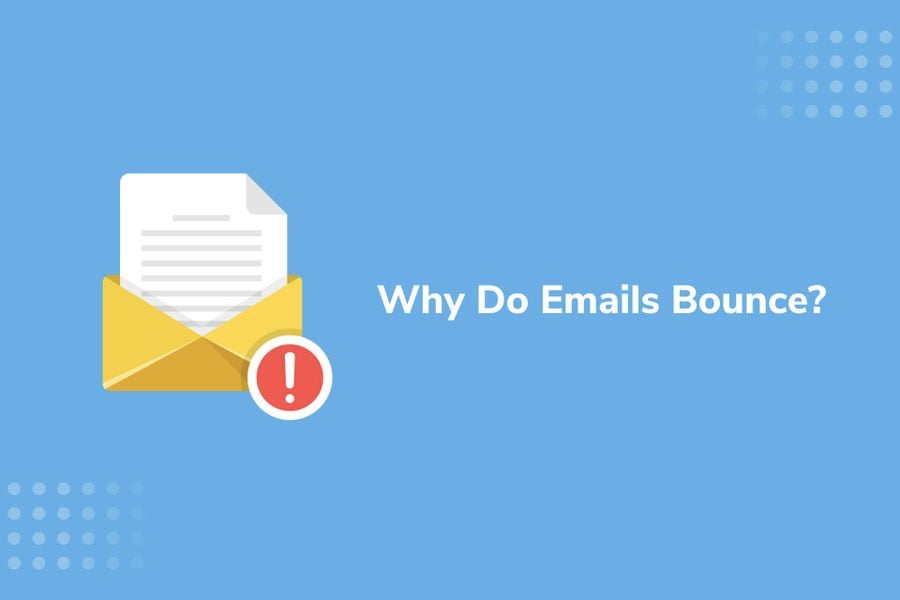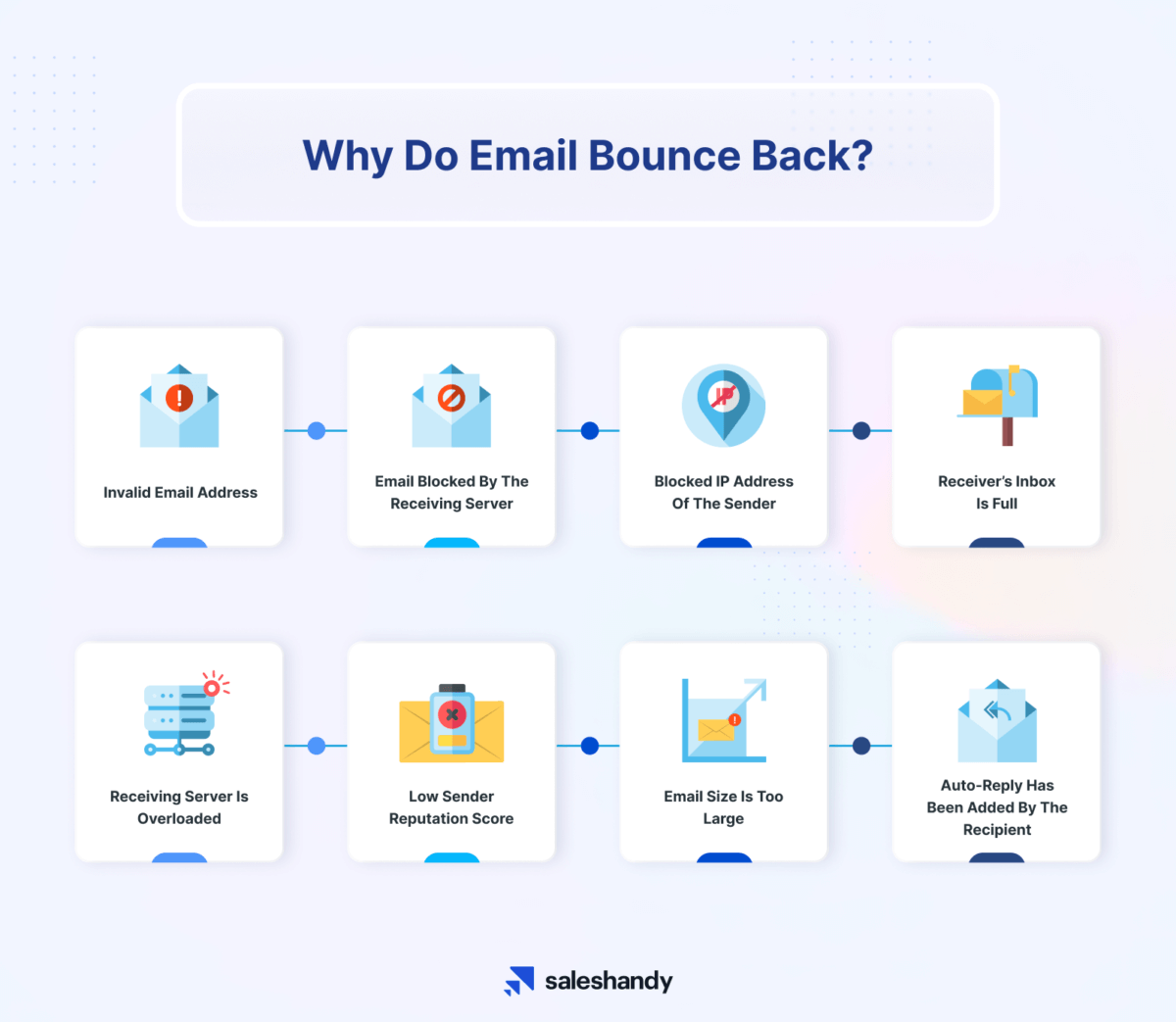Emails bounce when they cannot be delivered to the recipient’s inbox. This is a common issue in email marketing and communication.
Understanding why emails bounce is crucial for maintaining effective communication and a healthy email list. Bounced emails can impact your sender reputation and reduce the success of your email campaigns. There are various reasons for email bounces, including invalid addresses, full mailboxes, and server issues.
Knowing these reasons helps you address and prevent future bounces. In this blog post, we will delve into the causes of email bounces, how they affect your email strategy, and tips to minimize them. Stay tuned to ensure your emails reach their intended recipients efficiently.
Common Reasons For Email Bounces
Emails bounce for many reasons. Understanding these reasons helps improve email delivery. Here are some common reasons for email bounces.
Invalid Email Addresses
One major reason emails bounce is invalid email addresses. This means the address does not exist.
- Typos in the email address
- Non-existent domain names
- Deactivated email accounts
To avoid invalid email addresses, double-check them before sending.
Full Mailbox
A full mailbox is another cause for email bounces. It happens when the recipient’s inbox is full.
- The recipient has not cleared their inbox
- The mailbox has a small storage limit
To resolve this, ask the recipient to clear space in their mailbox.

Credit: woodpecker.co
Types Of Email Bounces
Understanding why emails bounce is crucial for any email marketer. There are two main types of email bounces: hard bounces and soft bounces. Each type has different causes and impacts your email deliverability in unique ways. Let’s explore these types in detail.
Hard Bounces
Hard bounces occur when an email cannot be delivered permanently. This means there is a fundamental issue with the recipient’s email address. Common reasons for hard bounces include:
- The email address does not exist.
- The domain name is incorrect.
- The recipient’s email server has blocked your email.
Hard bounces should be addressed immediately. They can harm your sender reputation. It’s best to remove these email addresses from your list. This will improve your email deliverability and keep your list clean.
Soft Bounces
Soft bounces are temporary issues that prevent email delivery. Unlike hard bounces, they might be resolved over time. Common reasons for soft bounces include:
- The recipient’s mailbox is full.
- The email server is temporarily down.
- Your email is too large.
Soft bounces are not as critical as hard bounces. But they still need attention. Reattempting to send the email later can sometimes resolve the issue. Monitoring these bounces helps maintain good email deliverability.
Here’s a quick comparison table to summarize the differences:
| Criteria | Hard Bounces | Soft Bounces |
|---|---|---|
| Issue Type | Permanent | Temporary |
| Common Causes | Non-existent email, incorrect domain, blocked email | Full mailbox, server down, large email |
| Action Needed | Remove email from list | Retry sending later |
By understanding the types of bounces, you can better manage your email lists. This ensures higher deliverability and better engagement with your audience.
Impact Of Bounced Emails
Emails that bounce can cause many problems for your business. They can affect your email deliverability and damage your reputation. Understanding these impacts can help you take corrective actions.
Effect On Deliverability
Bounced emails affect your email deliverability. The more emails bounce, the harder it becomes to reach your audience. Email service providers (ESPs) monitor bounce rates. High bounce rates suggest poor list management. ESPs may then direct your emails to the spam folder. This reduces the number of people who see your emails.
Also, a high bounce rate can lead to your account being flagged. This could result in temporary or permanent suspension from your ESP. Hence, maintaining a low bounce rate is essential for good deliverability.
Reputation Damage
Bounced emails can also damage your sender reputation. A high bounce rate signals to ESPs that your emails are unwanted. This can lead to blacklisting. Being blacklisted means your emails are blocked by many email providers.
Your brand’s credibility suffers too. Recipients who see your emails bouncing may think your business is not professional. This can lead to lost customers and reduced trust in your brand.
Maintaining a clean email list is crucial for avoiding these issues. Regularly removing invalid addresses can help keep your bounce rate low. This protects your reputation and ensures your emails reach the intended audience.

Credit: onesignal.com
How To Reduce Email Bounces
Email bounces can be frustrating and harm your email marketing efforts. Reducing email bounces helps maintain a good sender reputation and ensures your messages reach the intended recipients. Implementing effective strategies can significantly lower your bounce rate.
Regular List Cleaning
Keeping your email list clean is essential. Regular list cleaning helps remove invalid or outdated email addresses. This process improves your delivery rate and reduces bounces.
Here are some steps for effective list cleaning:
- Identify and remove hard bounces
- Correct typos in email addresses
- Eliminate duplicate entries
- Remove inactive subscribers
Using an email verification tool can automate this process. It ensures that your list remains up-to-date and valid.
Double Opt-in
Double opt-in adds an extra layer of verification. It ensures that people genuinely want to receive your emails. This method reduces the chances of fake or mistyped email addresses entering your list.
Here’s how double opt-in works:
- Subscriber enters their email on your signup form.
- They receive a confirmation email with a verification link.
- They click the link to confirm their subscription.
This method not only reduces bounces but also improves engagement rates. Subscribers who complete the double opt-in process are more likely to interact with your emails.
Incorporating these strategies can make a significant difference. Your email campaigns will reach more valid recipients, improving your overall email marketing performance.
Preventing Hard Bounces
Hard bounces can harm your email deliverability and sender reputation. Preventing hard bounces is crucial to maintaining a healthy email list. This section will guide you through essential practices like validating email addresses and avoiding spam traps.
Validating Email Addresses
Validating email addresses ensures you are sending emails to real and active users. Here are some effective ways to validate email addresses:
- Double opt-in: Ask users to confirm their email address.
- Email verification tools: Use tools to check the validity.
- Regular list cleaning: Remove invalid or inactive emails.
These practices can significantly reduce the chances of hard bounces.
Avoiding Spam Traps
Spam traps are email addresses used to catch spammers. Sending emails to spam traps can damage your reputation. Follow these tips to avoid spam traps:
- Use reputable email providers: They help filter out spam traps.
- Avoid buying email lists: Purchased lists often contain spam traps.
- Monitor engagement: Pay attention to user interactions.
By following these steps, you can avoid falling into the trap and maintain a clean email list.
Managing Soft Bounces
Soft bounces happen when an email cannot be delivered to the recipient’s inbox. This is usually due to temporary issues. Managing soft bounces is crucial to ensure your emails reach their targets. It helps in keeping your email list clean and your sender reputation intact.
Retry Strategies
Sometimes, emails bounce because the recipient’s mailbox is full. In such cases, retrying to send the email after some time can be effective. Implementing automated retry strategies can help mitigate this issue.
- Retry sending the email after 24 hours.
- Schedule multiple retries over a period of 3 days.
- Use different time intervals for each retry.
Additionally, fine-tuning your email delivery settings can improve success rates. Ensure your email server is configured to handle retries efficiently.
Monitoring Server Issues
Server issues can cause emails to bounce. Regularly monitoring your email server helps identify and fix such issues promptly.
| Issue | Action |
|---|---|
| Server downtime | Check server status and restart if needed. |
| High server load | Upgrade server capacity or optimize performance. |
| Configuration errors | Review and correct server settings. |
Using monitoring tools can simplify this task. These tools alert you to any issues in real-time, allowing for quick resolution.
Tools For Bounce Management
Emails bounce for many reasons. Managing these bounces is crucial for maintaining a healthy email list. Effective bounce management tools help prevent future bounces and improve email deliverability.
Email Verification Services
Email verification services check the validity of email addresses. These tools identify invalid or inactive emails before you send your campaign. This reduces the chances of bounces. Popular email verification tools include ZeroBounce, NeverBounce, and Hunter. They ensure your email list is clean and updated.
Analytics Tools
Analytics tools track email performance. They provide insights into bounce rates and reasons for bounces. Tools like Google Analytics and Mailchimp offer detailed reports. These reports help you understand and address bounce issues. With analytics, you can adjust your strategies and improve your email campaigns.

Credit: onesignal.com
Best Practices For Email Deliverability
Ensuring your emails reach the inbox is crucial. Many emails bounce due to poor deliverability practices. Implementing best practices can significantly reduce bounce rates and improve engagement.
Maintaining Engagement
High engagement rates are key to successful email deliverability. Engaged recipients are more likely to open and interact with your emails. Follow these tips to maintain engagement:
- Segment your audience: Tailor your content to specific groups.
- Personalize your messages: Use recipients’ names and relevant information.
- Send relevant content: Ensure your emails match recipients’ interests.
- Monitor engagement metrics: Track open and click rates regularly.
Proper Email Formatting
Proper formatting ensures your emails look professional. It also helps avoid spam filters. Here are some formatting tips:
| Formatting Aspect | Best Practice |
|---|---|
| Subject Line | Keep it short and relevant. Avoid all caps and excessive punctuation. |
| HTML and Text Versions | Provide both versions. Some email clients may not support HTML. |
| Images | Use alt text for images. Ensure images are optimized for quick loading. |
| Links | Use clear and descriptive anchor text. Avoid excessive links. |
Following these best practices can greatly improve email deliverability. Your emails are more likely to reach the intended recipients and stay out of the spam folder.
Frequently Asked Questions
What Causes Email Bounces?
Email bounces occur when an email cannot be delivered to the recipient’s inbox. Common causes include invalid email addresses, full inboxes, or server issues.
How Can I Reduce Email Bounces?
To reduce email bounces, ensure your email list is up-to-date. Regularly remove invalid addresses and verify emails before sending.
What Is A Hard Bounce?
A hard bounce happens when an email is permanently undeliverable. This can be due to invalid addresses or non-existent domains.
What Is A Soft Bounce?
A soft bounce is a temporary issue preventing email delivery. Causes include full inboxes or temporary server problems.
Conclusion
Bounced emails can disrupt communication and business. Understanding why emails bounce helps. Common causes include incorrect addresses, full mailboxes, or server issues. Regularly clean your email list to reduce bounces. Ensure your content is not flagged as spam. Monitor your email campaigns closely.
This will improve delivery rates. Successful email delivery strengthens connections and boosts engagement. Keep learning and adapting your email strategies. This will enhance your communication efforts.
